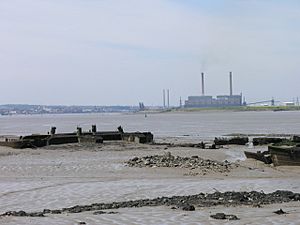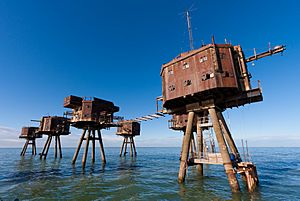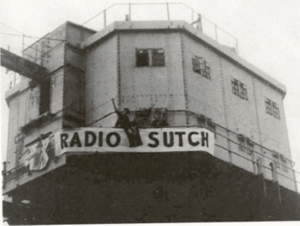Maunsell Forts facts for kids
Quick facts for kids Maunsell Sea Forts |
|
|---|---|
| Thames and Mersey estuaries | |
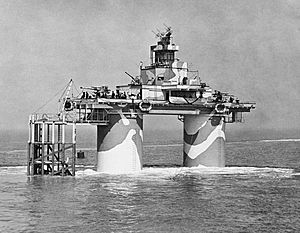
"Navy" style fort
|
|
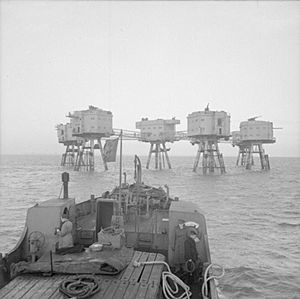
"Army" style fort
|
|
| Type | Fortified towers |
| Height | Approx 30–78 feet (9.1–23.8 m) |
| Site information | |
| Owner | |
| Open to the public |
Yes, in some cases |
| Condition | Decommissioned in the late 1950s |
| Site history | |
| Built | 1942–1943 |
| In use | Second World War |
| Materials | Concrete, metals |
| Events | Used during Second World War |
The Maunsell Forts are strong towers built in the Thames and Mersey estuaries. They were created during the Second World War to help protect the United Kingdom. These forts were used by both the army and the navy. They are named after their designer, Guy Maunsell.
The forts were stopped from being used in the late 1950s. After that, people used them for other things, like broadcasting pirate radio stations. One of the forts is now managed by the Principality of Sealand, which is a small, unrecognised nation. Boats sometimes visit the other forts. A group called Project Redsands is working to save the fort at Red Sands.
In 2007 and 2008, a radio station called Red Sands Radio broadcast from the Red Sands fort. It was a tribute to the pirate radio stations of the 1960s. However, the fort was later found to be unsafe. Red Sands Radio then moved its operations to land.
Before these forts, other forts were built in river mouths to defend against ships. Examples include the Grain Tower Battery (1855) and the Plymouth Breakwater Fort (1865). There were also the Spithead Forts (1865-80) and the Humber Forts (1919). The Nab Tower was also built around this time.
Contents
The Maunsell naval forts were built in the Thames estuary. The Royal Navy operated them. Their main job was to stop and report German air raids that followed the Thames. They also prevented enemy aircraft from laying mines in this important shipping channel.
There were four naval forts:
- Rough Sands (also known as HM Fort Roughs) (U1)
- Sunk Head (U2)
- Tongue Sands (U3)
- Knock John (U4)
These forts were like early offshore oil platforms. Each fort had a large concrete base, about 168-by-88-foot (51 by 27 m). Two hollow concrete towers, 60-foot (18 m) tall and 24-foot (7.3 m) wide, supported this base. The walls were about 3.5 inches (9 cm) thick. Each fort weighed around 4,500 tons.
The twin concrete towers had seven floors inside. Four floors were for the crew to live in. The other floors were for dining, operations, and storage. They held generators, fresh water tanks, and anti-aircraft ammunition. A steel frame at one end held a landing jetty and a crane. This crane was used to lift supplies onto the fort. The wooden landing stage was called a "dolphin."
A steel platform deck connected the towers above the water. This deck became a gun deck. An upper deck and a central tower were built on top of it. QF 3.75 inch anti-aircraft guns were placed at each end of the main deck. Two more Bofors 40 mm anti-aircraft guns were also there. Radar equipment was on top of a central living area. This area had a kitchen, medical room, and officers' quarters.
These concrete structures were built like strong military bunkers. Their underwater ends were firmly fixed into the ground. Many fish live near the forts because the forts provide shelter. The forts also serve as important landmarks for ships. They were built in dry docks as complete units. Crews went on board to get used to them. Then, they were towed out and sunk onto their sandbank spots in 1942.
During World War II, the Navy forts in the Thames estuary destroyed one German E-Boat (a type of torpedo boat).
Rough Sands Fort (U1): Home of Sealand
Rough Sands fort was built to protect the ports of Felixstowe, Harwich, and the town of Ipswich. It defended them from attacks by air and sea. It is located on Rough Sands, a sandbar. This sandbar is about 11 kilometres (6 nmi) from the coast of Suffolk and 13 kilometres (7 nmi) from the coast of Essex.
Fort Roughs was the first of four naval forts designed by G. Maunsell. It was built in a dry dock at Red Lion Wharf, Gravesend. It was officially named "H.M. Fort Roughs" on February 8, 1942. After a journey, it was placed on the sandbank on February 11, 1942. Almost 100 men were already on board, and the fort began service right away.
In 1966, Paddy Roy Bates, who ran Radio Essex, and Ronan O'Rahilly, who ran Radio Caroline, landed on Fort Roughs. They took it over. However, after some disagreements, Roy Bates claimed the tower for himself. O'Rahilly tried to take the fort in 1967, but Roy Bates defended it. The British Royal Marines were put on alert, and British authorities told Roy Bates to give up. He and his son were arrested and charged. But the court dismissed the case. This was because Roughs Tower was outside Britain's territorial waters, meaning the court had no power over it.
Roy Bates saw this as a sign that his country was real. Seven years later, he created a constitution, flag, and national anthem for the Principality of Sealand. This "nation" was founded on September 2, 1967.
Sunk Head Fort (U2): Blown Up
Sunk Head fort was about 18 kilometres (10 nmi) off the coast of Essex. It was placed on June 1, 1942. The fort was stopped from being used on June 14, 1945. It was kept in good condition until 1956, when it was left empty.
Sunk Head was clearly outside British waters. When the Marine Broadcasting (Offences) Act came into effect in August 1967, the government wanted to make sure no offshore broadcasters would take it over again. So, on August 18, 1967, soldiers from the Royal Engineers boarded Sunk Head. They weakened the fort with cutting torches. Then, they set 3,200 pounds of explosives. On August 21, 1967, Sunk Head was blown up. Only 20 feet of its leg stumps remained.
Tongue Sands Fort (U3): Collapsed in a Storm
Tongue Sands Fort was about 10.2 kilometres (6 nmi) off the coast of Margate, Kent. It was placed on June 27, 1942. On the night of January 22/23, 1945, German E-Boats were seen on radar. One E-Boat came under heavy fire from Tongue Sands Fort's guns. The German captain was unsure where the attack was coming from. He moved his boat to avoid being hit, and accidentally crashed into another E-Boat. The captain then sank his badly damaged vessel.
Tongue Sands Fort was stopped from being used on February 14, 1945. It was maintained until 1949, when it was abandoned. The fort had not settled well when it was first placed, making it unstable. On December 5, 1947, the fort shook violently, and parts began falling into the sea. The crew sent a distress call and were rescued. Divers later found that the foundations were solid. However, in a later storm, the fort tilted by 15 degrees. By the mid-1960s, the fort had become even more damaged. Large holes appeared, water flooded the lower levels, and the platform came apart. Tongue Sands Fort finally collapsed during storms on February 21/22, 1996. Only an 18-foot stump of one leg remains visible.
Knock John Fort (U4): Still Standing
Knock John fort is about 16.1 kilometres (9 nmi) off the coast of Essex. It was placed on August 1, 1942. It was stopped from being used on June 14, 1945, and emptied on June 25, 1945. The platform was maintained until May 1956, when it was abandoned. In 2009, people noticed a slight bend in the legs when looking at the tower from west to east. This is thought to be caused by erosion around its base.
Maunsell Army Forts: Anti-Aircraft Defense
Maunsell also designed forts for anti-aircraft defense. These were larger structures with seven steel platforms connected together. Four towers were arranged in a half-circle in front of the control center and living areas. Each of these towers held a QF 3.75 inch gun. A tower behind the control center had Bofors 40 mm guns. The seventh tower, set to one side, was the searchlight tower.
Three of these forts were placed in Liverpool Bay:
- Queens AA Towers
- Formby AA Towers
- Burbo AA Towers
And three were placed in the Thames estuary:
- Nore (U5)
- Red Sands (U6)
- Shivering Sands (U7)
The forts for Liverpool were built at Bromborough Dock. The Thames forts were built at Gravesend. Plans to build forts off the Humber, Portsmouth, Rosyth, Belfast, and Londonderry never happened. During World War II, the Thames estuary forts shot down 22 aircraft and about 30 flying bombs. The Ministry of Defence stopped using them in the late 1950s.
Nore Fort (U5): Damaged and Dismantled
Nore fort was the only one built inside British territorial waters at that time. Other forts were in international waters. In 1953, the fort was badly damaged during a storm. Later that year, a Norwegian ship, Baalbek, crashed into it. This destroyed two towers, killed four people, and ruined guns and radar equipment. The damaged fort was a danger to ships. So, it was taken apart in 1959–60. Parts of the bases were towed ashore near the village of Cliffe, Kent. They can still be seen at low tide.
Red Sands Fort (U6): A Visitable Fort
There are seven towers in the Red Sands group at the mouth of the Thames Estuary. These towers used to be connected by metal walkways. In 1959, people thought about moving the Red Sands Fort ashore. However, the costs were too high. In the early 21st century, a group called Project Redsands was formed. They wanted to save the fort from being torn down. This is the only fort that can be safely visited from a platform between the legs of one of its towers.
Shivering Sands Fort (U7): An Artist's Home
This group of forts was built near the Thames estuary for anti-aircraft defense. It was made up of several towers north of Herne Bay, about 9.2 mi (8.0 nmi; 14.8 km) from the nearest land. One of the seven towers collapsed in 1963. This happened when a ship called Ribersborg crashed into it during fog.
In 1964, the Port of London Authority put wind and tide monitoring equipment on the Shivering Sands searchlight tower. This tower was separated from the rest of the fort by the collapsed tower. The equipment sent data to the mainland using a radio link. In August and September 2005, an artist named Stephen Turner lived alone in the searchlight tower for six weeks. He called it "an artistic exploration of isolation." He wanted to see how time felt different when alone and what creative thinking meant in today's world.
Liverpool Army Forts: Demolished for Safety
The Liverpool sea forts were built like the Thames estuary forts. They were designed to defend Liverpool and its industrial areas from air attacks from the west. Originally, 38 towers were planned, but only 21 were built (forming three forts). Construction began in October 1941. None of these forts faced enemy action during World War II.
Taking apart these forts started in the 1950s. They were seen as a danger to shipping, so they were a priority over the Thames estuary forts. Demolition was delayed in 1954. This was because the salvage ship working at Queens Fort had to help with the urgent demolition of The Nore Fort in the Thames Estuary. The Nore Fort had been damaged in a ship collision and was a hazard. The demolition of the three Liverpool forts was finished in 1955.
Pirate Radio Stations: Broadcasting from the Sea
Various forts were taken over by pirate radio stations in the mid-1960s. These stations broadcast without a proper license.
In 1964, a few months after Radios Caroline and Atlanta started broadcasting, Screaming Lord Sutch set up Radio Sutch in one of the Shivering Sands towers. Sutch soon got tired of the project. He sold the station to Reginald Calvert, who had helped set it up. Calvert renamed the station Radio City. He expanded operations into all five connected towers. A dispute over the station's ownership led to a tragic event, which contributed to the government passing laws against offshore stations in 1967.
During the pirate radio era, the Port of London Authority often complained. They said that Radio City's transmitter was interfering with their radio link.

Red Sands was also taken over by Radio Invicta. This station was renamed KING Radio, and then Radio 390. Its wavelength was about 390 meters. The station's manager was Ted Allbeury, an ex-spy and writer.
The large size of the Army forts made them great places for antennas. A big antenna could be placed on the central tower and held up by wires from the surrounding towers.
A small group of radio fans set up Radio Tower on Sunk Head Naval fort. But the station had very little money, poor coverage, and only lasted a few months. The group also claimed they would start a television service from the fort, but this was never believable. To stop more pirate broadcasting, a team of Royal Engineers placed 2,200 pounds of explosives on Sunk Head. This began on August 18, 1967. At 4:18 PM on August 21, the explosives were set off. This destroyed the entire top part of the fort and most of the concrete legs above the water.
Paddy Roy Bates took over the Knock John Fort in 1965. He set up Radio Essex, later called BBMS (Britain's Better Music Station). But he is more famous for what he did after pirate radio. After BBMS closed in late 1966, he moved the station's equipment to Roughs Tower, which was further from the coast. However, he did not start broadcasting again. He, or someone representing him, has lived in Roughs Tower since 1967. He calls the tower the Principality of Sealand.
See also
 In Spanish: Fortalezas Marinas Maunsell para niños
In Spanish: Fortalezas Marinas Maunsell para niños





